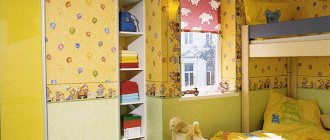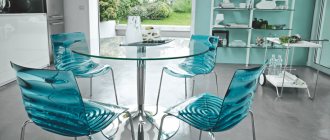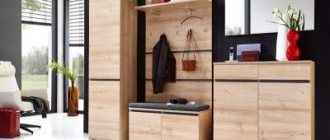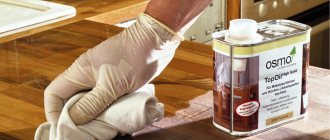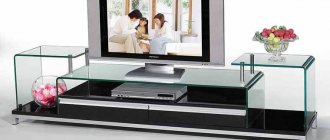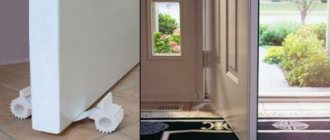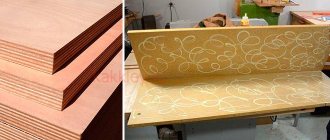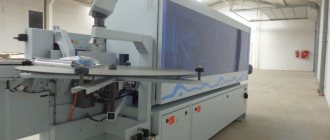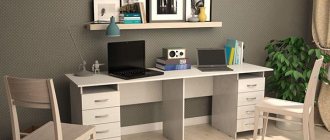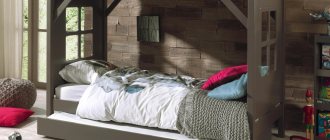Types and models of blockers
Locking locks are designed for hinged sashes and doors. Depending on the type of handles on the doors, they come in different shapes. These locks are very easy and quick to install on cabinet handles and securely hold the doors in the closed position. Door locks of this type look neat and will not damage your furniture. They do not tear or stretch when opened and closed multiple times, and are quite strong and durable.
For sliding doors and drawers in a chest of drawers or cabinets, soft Velcro locks are suitable. They are attached to the side and front surfaces of the furniture and connected with a special fastener, thereby keeping the drawer from sliding out. Depending on the model, the locking mechanisms may be different: special hidden buttons, hooks and ears. Locks of this type can also be used to lock the doors of kitchen appliances that are dangerous for children (refrigerator, microwave oven, oven). After all, the baby is unlikely to limit his travels to the living room and his children's room.
To protect the child from a heavy box falling on his feet, you can attach special latches that block the extension. Even if a young fidget somehow manages the lock blocking the drawer, the latch will work when pulled out and will not allow the drawer to be pulled out of the cabinet too far. Such devices are attached to the inside of the furniture and block the movement of the drawer to a certain amplitude. Fastening is carried out either using bolts or using holders glued to the inner surface of the box
More expensive models of locks and security devices are often equipped with a special built-in sensor that emits an audible signal when an attempt is made to open incorrectly (pulling the handle while the lock is closed or applying force to the mechanism itself). The intensity and type of sound signal can be adjusted through the settings. For vigilant parents, this is undoubtedly a significant advantage.
Types of blockers
There are several main types of blockers. The difference lies in the method of attaching the device to furniture and the features of their functioning. There are Velcro-type blockers and permanently mounted ones.
Main types of door locks:
- Locks are interlocks that lock onto handles from the outside. The device securely closes the door leaves, which helps protect the contents from damage and the baby’s fingers from injury. The mechanism of the device is a plastic cord with notches, which are fixed with a special attachment. The handles are braided with cord and closed with a “lock”. The advantage is that adults can easily open the mechanism, but children cannot;
- a universal lock connecting the door of a cabinet or chest of drawers to the body. The mechanism is a silicone strap, which is secured with clasps on the sides. The advantage lies in the versatility of the fixation, since it can easily be used on drawers and doors where there are absolutely no handles;
- shock absorbers blockers - devices of this type are made from elastic and at the same time durable materials: plastic, foam rubber, rubber, silicone. It does not close the door, but, on the contrary, does not allow it to open completely or close completely. Thus, the baby will not be able to nail his fingers. A shock-absorbing blocker is installed in the upper part of the door;
- locks for sliding doors, for example, for sliding wardrobes. Often the device is made of plastic, and its mechanism completely replicates the design of the door, where the strap is secured with a special fastener. It is impossible for a child to cope with the mechanism, but for an adult it is easy to open the door with such a lock;
- internal lockers are mounted on screws and are a retractable structure that will not allow opening a chest of drawers or cabinets. In addition, this detail does not attract too much attention from the child and does not spoil the appearance of the furniture.
It is better to choose blockers and other security elements that do not stand out against the background of the overall design of the room, so that they do not attract too much attention from the baby. There are blockers for other needs - fixing plastic windows, a device for limiting door locks. The main thing is to choose the right device for the corresponding door or drawer.
Shock absorber
External
Interior
On the compartment door
Universal
Adhesive based
Basically, all blockers for openings and boxes are intended for external use. Attaching the device to furniture with screws can ruin its appearance. Therefore, other methods of attaching blockers are used - an adhesive base.
This device consists of two “buttons” that are glued to a wooden body. A silicone or woven strap is stretched between the buttons. After removing the elements, the glue is easily removed and leaves no traces on the surface.
Advantages of adhesive-based blockers:
- product availability;
- a huge variety of design solutions regarding color and design;
- strength in fastening;
- easy to dismantle, does not leave marks on the surface of the furniture;
- does not require special materials for fastening.
When choosing an adhesive-based device, you should definitely pay attention to the integrity of the packaging and expiration dates. These conditions may affect the quality of the attachment.
Thanks to unique manufacturing technologies, you can choose a device whose adhesive base is completely environmentally friendly. The child should choose hypoallergenic materials.
For internal mounting
Drawers and cabinet doors often use mechanisms that are mounted on the inside. Thanks to the unique method of fastening and functional features, this type of blockers offers many advantages.
The internal fastening blocks are applied using adhesive tape with a special adhesive composition. Since the mounting location will not be visible from the inside, you can choose models with screw fastening.
Advantages of internal mounting:
- blocking does not spoil the appearance of the furniture;
- there is no risk of surface damage;
- does not attract children's attention;
- there is no need to select the product in accordance with the interior of the room;
- a wide range of functional features.
For blockers of this type, the main thing is strength, since they must withstand enormous loads. The design can be homogeneous and consist of two separate parts.
U and C shaped
Types of protection have not only features in the method of fastening. Some devices also differ in shape. Often the operating features depend on this. There are U- and C-shaped shock absorbers; locks of this type are not attached to drawers and doors - they are used mainly for interior doors.
There are U and C shaped handle latches. Thanks to them, furniture elements cannot be opened. These devices snap tightly and prevent the baby from getting inside. These elements are made of high-quality plastic.
For adults, this latch is advantageous because it can be dismantled very easily and quickly. There is no need to think about how to secure the blocker elements. A simple and quick method of installation and dismantling is another advantage of this particular child protection device.
U shaped C shaped
Additional protection elements
In addition to door and drawer locks, there are other methods of protection for this type of furniture. Sharp corners are especially dangerous. Depending on the height of the chest of drawers, cabinets or cabinets, protection is chosen.
Corner covers come in several types:
- fixed corners - this device only covers a corner with a small range. It is made mainly from silicone or rubber;
- special soft balls - the softening element is placed directly on the corner;
- soft tape - the range of softening corners is very large. You can protect a large area of furniture surface.
Soft tape may not be suitable for a closet, but for cabinets and chests of drawers it is the best protection option.
In addition to corners, for the safe operation of furniture such as cabinets, chests of drawers and wardrobes, special belts are used for fastening. One part is securely screwed to the wall, and the second directly to the furniture. Thanks to this fastening, it is impossible to knock over the furniture.
Drawer solutions
Some will say that you can hang regular magnetic locks on the drawers. But powerful magnets are expensive, but simpler options will not withstand even the efforts of a child.
For curious children, drawers are of great interest. They are easy to hit and pinch fingers when actively opening and closing.
The essence of the protective mechanisms is to block the extension of the structure. The blocker is secured from the inside using screws.
There are 2 main types of locks for drawers.
- Internal. The mechanism structure is located inside. Locks with holes are glued to the shelf of the drawer, and the hook to the front;
- External. Two elements are attached to the box. One is pressed to the side, and the other to the edge. When closing, the locking elements are connected to each other and latching occurs.
Most often, plastic clips are used for drawers. They are inexpensive, easy to use, but difficult for a child to understand.
After use, when the child grows up, the lock can be removed. The big plus is that they don’t leave any marks on the furniture.
Child protection on corners
When a child is running around the house, it is easy for him to bump into the corner of a table or furniture. Especially for such cases, manufacturers have created corner protection, which consists of small soft corners. These corners are glued to all corners, you can also stick them on sharp door handles.
Such corners can be silicone and completely transparent. Or they can be soft and made in different colors. Therefore, you can choose colors to suit your taste, and then the interior of your apartment will not suffer. Correctly and tastefully selected corners can give the apartment a unique charm and additional comfort.
Such corners are inexpensive, so you can buy them for absolutely all the sharp corners that you have in your home, and your budget will not suffer from this at all.
Child protection for furniture
Children also often hit their heads on the sharp edge of the table and on the corners of cabinets. To avoid this, you can paste the edges of the tables with special soft stickers. These stickers come in different colors and are very easy to match with your interior design.
Also, the corners of the cabinets can be covered with protective tape, which can be easily matched to the style of the interior and the color of the furniture, thanks to the variety of colors.
This tape comes in several types:
- thick;
- thin;
- straight;
- ribbed;
- horseshoe-shaped;
- arcuate.
Child protection for drawers
Children love to open desk drawers. The box may open abruptly, causing the child to fall and injure himself. Also, desk drawers usually contain important documents that a child can pull out and damage. To prevent the locker from opening, you can use special child locks.
Such locks are made so that a child cannot open them with his own hands, while an adult can easily open these locks. These locks are inexpensive, so you can purchase one for all the drawers in the house.
There are several types of such constipation. Each type of lock corresponds to a specific type of furniture. You can also use a special Velcro safety tape for such purposes.
The disadvantage of such protective devices is that they can seriously spoil the design of the apartment. To keep the interior as normal as possible, you need to buy protection that matches the color of the furniture. In any case, it is better to sacrifice interior design than the health of the child.
How do child locks work on drawers and cabinets?
Just recently your little child was born, and now he is actively exploring every corner of the apartment.
The lock prevents hanging drawers from opening completely.
This is where it becomes necessary to think about the safety of the little explorer from unwanted objects and sharp corners, doors and drawers, to which the young know-it-all is drawn like a magnet.
By using protection on drawers and cabinet doors, you can prevent unwanted opening by a child.
Fortunately, the modern market is rich in all kinds of devices that can completely protect a child from possible injuries and dangers that await him in the house.
To protect the contents of the drawers from the baby, you need to use a lock on the drawers.
For parents, such things will give them more peace of mind, and will also help them get rid of the extra work associated with putting things back into cabinets that have been ruined by the baby.
Prevents drawers and refrigerators from opening.
As soon as the baby begins to stand on his feet or actively crawl around the house, parents have to think about the possible dangers that lurk within the walls of the apartment.
Prevents drawers from opening and children from getting hurt.
Cabinets and drawers with potentially dangerous objects attract a small child, and the doors themselves can injure the baby by pressing his fingers.
Prevents drawers from opening and children from getting hurt.
To prevent a child from opening cabinets, there are child locks on furniture that are resistant to children's hands.
Prevents unplanned opening of cabinets and equipment.
Such locks are inexpensive, so purchasing them is very advisable.
The lock prevents hanging drawers from opening completely.
The type of lock directly depends on the nature of the furniture being locked and how it opens. After all, to protect a retractable drawer from a little robber, you need a completely different device than for a cabinet with doors.
The universal Velcro safety tape provides protection against your little one opening the refrigerator, toilet seat, desk drawers, etc.
The need to protect furniture
A small child finds everything that happens around him interesting, so situations often arise that threaten the baby’s health. The time when children begin to crawl and walk is considered especially dangerous, since the danger will be from sharp corners and doors of furniture, sockets, and household appliances. Young children especially actively begin to explore the world from the contents of the closet and shelves. Some things can be removed or moved higher, but the sharp corners of tables, sofas, chairs, and drawers remain.
Even if you protect sharp furniture elements, the question arises regarding the contents of cabinets, cabinets, and drawers. The baby can open the door and easily get to small items, dangerous devices and valuables, and medicines. Therefore, it is important to take care to make it difficult for a child to penetrate into pieces of furniture.
To reduce the risk of injury to a child, caring parents resort to tricks - installing protection, limiters and blockers. Sometimes such devices are made independently, but a more reliable option is special products that can be purchased at hardware stores.
Advantages and disadvantages of products
Ingenious devices for locking doors and furniture make life much easier for parents. This device has many advantages and virtually no disadvantages.
Here are examples of the advantages of interlock locks:
- compact, practical, versatile;
- high quality;
- durability and possibility of repeated use;
- ease of installation allows you to independently install the lock in the required location without using special tools;
- affordable price;
- the attractive design of the locks does not spoil the appearance of doors and furniture, but gives them additional decor;
- can be easily removed when they become no longer relevant;
- does not scratch furniture thanks to the Velcro on which they are attached;
- the locks are made of hard plastic that a child cannot break;
- Adults can easily open the child lock.
There are only two small disadvantages:
- The lock can only be attached to a perfectly flat surface without rough edges or protrusions;
- As a child grows up, he will learn to open locks by watching adults, so the simplest locks that do not require force are suitable only for children.
To protect older children, locks that require force to open should be used.
Closing the closet from the child
Hinged cabinet doors are also better protected from children. Otherwise, leaving him alone for a minute, you risk returning to the room to find a pile of linen from the lower shelves and your little one happily frolicking with him. As a rule, U-shaped latches are installed on swing doors.
This is the simplest method of protection, since it does not require drilling holes in the furniture, or even gluing the protection to the surface of the furniture.
You can also use latches in the form of plastic hooks. They consist of two parts: the first part is attached to one cabinet door, and the other - the hook itself - is installed on the other door. When the doors are closed, the cabinet is locked with a hook.
The closet door can also be locked. A mirror on a wardrobe is a very attractive item for a baby. Usually, small children enthusiastically roll closet doors, look at their reflection in the mirror, and drag all the things from the lower shelves to the floor.
Of course, devices that are installed on hinged cabinets are not suitable for sliding wardrobes. But still, today there is protection for such furniture. The most popular type of security for sliding wardrobes is the butterfly latch. It is installed on one of the doors, next to the second door. When the “wings” are lowered, the cabinet door is in a movable state. By pressing a special button, the “butterfly wings” rise and prevent the cabinet door from rolling.
Covers for sharp corners of furniture
Danger for a child can come from different places; one awkward move and you can get injured, even while in the room. Sharp corners of furniture that can seriously injure a child are another dangerous place that needs to be taken care of.
What are they?
There are different types of corner covers:
- Fixed corners - covers exceptionally acute corners.
- Soft balls - fixed only at an angle.
- Soft tape - differs in that it can provide a greater range of softening.
Note! Soft tapes are not suitable for use on cabinets.
How to install them
To ensure the safety of the child, it is necessary to worry not only about blocking the handles, but also to soften sharp corners, which are much more dangerous. In order for such corners to perform their function, they must be properly secured:
- checking the packaging for damage;
- preliminary preparation of the chest of drawers;
- place all parts opposite each other;
- attach the part and press with your hand for maximum fixation.
Deviation from the sequence and correct execution of the steps may distort the quality of the locking or lining.
How to protect children from dangerous cabinets and cabinets
To prevent unwanted child access to cabinets and drawers where dangerous items may be stored, there are special child locks for cabinets. They are relatively inexpensive, which makes purchasing them more feasible.
Dangerous places for children include cabinets with electronics and various small items, cosmetics, medicines, dishes and kitchen utensils. You can protect not only the child, but also prohibited items.
Types of child locks
Each type of furniture, drawers and doors has its own locks. Some of them are attached with Velcro, while others are permanently attached with screws.
There are several types of child locks on doors and furniture:
- Locking locks for cabinet doors. They securely hold cabinet doors and prevent children from climbing inside or pinching their fingers. The lock is secured by a durable plastic cord with locking notches. Due to the fact that the cord is blocked by a rigid closure mechanism at three points and wraps around the handles, only an adult can open it.
Child lock on cabinet doors
- Universal lock - child protection allows you to connect the body of a bedside table or cabinet with a door or drawer. Most often it is made in the form of silicone straps with mechanisms at the edges. Can be installed on absolutely any furniture, even those that do not have handles. Convenient to use on drawers, because they pose the greatest danger to children due to the possibility of a sudden fall on their feet. Child protection on the bedside table
- Shock absorbers-blockers made of elastic material (rubber or soft plastic) are installed on the doors. Such protection does not allow the door to close completely, and the child will not get his hands pinched. It is placed next to the hinge or on the top edge of the door. Double folding doors can be secured in the closed position by a special lock. It is installed where the door is folded at the top. The product is recommended to be used from the moment the child learns to crawl. This blocker is designed for door thickness up to 15 mm.
The shock absorber can become an interesting decorative element
- In a home with children, self-latching locks are very unsafe. If your door has a handle with such a lock, it is recommended to install a device that will block it. Blockers must be selected individually for each handle. This protection opens and closes almost silently, which is convenient when the child is sleeping.
Reliable protection against children - handle lock
- Locks for sliding doors are also available. They are very convenient to use for locking sliding wardrobes and glass doors of cabinets and living rooms. Now your children will not be able to get hurt by taking out a dangerous object from prohibited places. In stores you can find child locks for glass doors.
Protection for glass doors
Elements for additional protection
In addition to locks and blockers, it is worth using additional protective elements, including:
- Corner protectors. The products are sold in various designs, which allows you to choose a suitable protector for any room: transparent for ordinary rooms and made in the shape of various animals for children's rooms.
Protectors can be either colored or transparent
- Stickers for the edge of the table. They are sold in the form of a long strip, which allows you to cut the product to fit any size and shape of the table (even for a round one). If you choose a color scheme that matches the furniture or wallpaper, the sticker will not spoil the appearance of the furniture.
The edges of tables can be protected with special stickers
- Hinge protection. The lock does not allow the loop to close completely, which means it eliminates the need to press your fingers. If the door needs to be closed, the product is hung on a special holder.
The door can be locked from accidental closing
Protecting children from dangerous doors and cabinets
To prevent unwanted access of a small son or daughter to a drawer or closet where dangerous objects are stored, special child locks are used. Their cost is relatively small, but the benefits are great.
Dangerous items include electronics, cosmetics, medications, small items, and kitchen utensils. Using a stopper on the sash, you can protect the child and these items that are prohibited. There are a large number of blockers of varying prices, so it’s realistic to choose according to your options.
For each door there are special locks with different fastenings: Velcro, screws. To lock the cabinet doors, a lock is used, which securely holds the panels and prevents the baby from climbing inside. For this, a plastic cord with notches is used, which is fixed by a rigid mechanism at 3 points. Only an adult will open this mechanism; children cannot do it.
Door lock
The universal lock, made in the form of silicone straps with mechanisms, perfectly secures the cabinet doors. It is installed on those surfaces where there are no handles.
In addition to stoppers and blockers, corner protectors and stickers on the edges of the table are used.
Interior door locks
You can also protect your baby from injury through interior doors using special locks. Some of them fix the door in one position, others simply do not allow it to slam shut.
- Locking door hinge lock. This is something like a spacer that fits between the door and the jamb. The lock is put on the door hinge and fixes the door in the desired position. (blocker “Zamochek” (about 80 rubles));
- Floor blockers. Such devices are installed between the door and the floor, fixing the door in a certain position and protecting it from slamming. They can be of different designs, made of plastic or rubber. Some even come in fun designs. — Clippasafe CL89 (about 250 rubles), door lock “Paw” (about 80 rubles);
- Door lock handle lock. Snap locks are not safe in a home with a child: the child may accidentally lock himself in the room. The door lock handle lock locks the handle in the open position and prevents it from latching. Such blockers are not universal; they are selected individually for each lock. Their cost ranges from 300 to 500 rubles.
Door shock absorbers. Simpler devices - soft door shock absorbers - also save you from sudden door slamming. They are made of rubber or soft plastic and are attached to the edge of the door. (Clippasafe with sound signal (about 170 rubles), BabyGo (about 69 rubles), Happy Baby Door Fixator (about 55 rubles).
Instructions for locking cabinets and cabinets from children:
- If the furniture is equipped with locks, then it is necessary to close all doors with keys, and then put them out of the reach of children.
- Hinged cabinet doors can be closed by tying adjacent handles together with rope. To do this, the rope is passed between the handles in the shape of a figure eight and tied in a knot. This method is suitable for shelves that are used on rare occasions.
- For doors and drawers that have to be used frequently, special protective devices purchased in children's and hardware stores are suitable. A locking lock is an easy-to-use and inexpensive mechanism that is designed for different types of doors. Using these locks, you can easily lock sliding, folding and swing doors with close adjacent handles. They are produced in various versions. For example, to lock swing doors, use U- and C-shaped locks and locking rings for cabinet handles. After dismantling, they do not leave any marks on the surface of the furniture.
- It is convenient to glue soft locks to sliding and glass surfaces without handles. Thanks to the adhesive surface of the clamps, they are easy to dismantle, because they do not leave marks on the furniture. The disadvantage of soft locks is that a child can learn to open them on their own, but this can be overcome by gluing the locks higher. In addition, these universal locks are used on the surface of the refrigerator, microwave oven, toilet lid and even on windows.
- The latches will help prevent the drawer from falling out on your feet. They are attached from the inside with screws or Velcro on the side from the outside. The side latch can only be opened by pressing the buttons simultaneously while pulling the drawer towards you.
There are many manufacturers of home security devices. The most popular are the following:
- Mothercare (UK);
- World of Childhood (Russia);
- Canpol (Poland);
- Chicco, Poupy, Brevi (Italy);
- Safety First (Netherlands);
- Baby Dan (Denmark);
- Bebe Confort (France);
- IKEA (Sweden).
Products of Polish and Russian brands have an affordable price, which can be 5-7 times lower than that of brands from European manufacturers, while the quality of their products is also at the same high level.
Even if you consider all these protective devices to be a whim of inventors, you will still have to come up with something at the moment when the baby learns to crawl. After all, literally everything falls into his field of vision - from a boiling kettle on the stove to a mosquito net on the windows. So, various protections are not a whim, but a necessity for those conscious parents who do not want to remember the first couple of years of the baby’s life as time spent in traumatology.
The danger of basic household items cannot be underestimated - burns, falls, bruises and fractures are possible, because the child does not know how to properly handle the familiar objects around us.
Safety for children at home: door lock
Types of locks for door leaves
When choosing door restraints for small children, you must remember that they should be difficult for a child to open. There are latches with a hidden button, with hook-eyes, with a plastic hook - the designs suggest easy opening for an adult, but difficulty for small children. The best option is to choose a locking device with a complex opening system, for example, with the simultaneous pressing of several buttons. And the main thing for the safety of children is to keep the front door locked so that the child does not go out on his own to explore the world.
To protect a small child from problems associated with doors, the following locks are used:
- Where there are small children in the room, self-latching door locks are dangerous. Therefore, a locking device is installed on such a handle.
Important! The blocker is selected individually. The lock opens and closes quietly, which is convenient if the child is resting.
Handle lock - reliable protection for the baby
- Doors with two leaves can be locked closed with a special stopper, which is installed on top at the points where the leaves are connected. This blocker is designed for a 15 mm door leaf. It is recommended to use the protective item from the moment the baby learns to crawl.
- Shock absorbers-blockers, which are installed on doorways, are made of durable material. This protection prevents the canvas from closing - a gap remains, and the little one will not pinch the handles.
Blocks from accidental closure
- The locking device is mounted next to the canopy between the door, jamb, or placed in the upper edge of the canvas.
- The assortment includes locks for securing sliding models, which are convenient to use for closing sliding wardrobes, glass doors, and living rooms. The little one will not be able to get hurt or get hold of forbidden items. There are also glass door stoppers.
Protection of glass models
- There are a lot of locks that protect interior doors from spontaneous opening/closing. As a result, children's health is safe. To solve this problem, floor locks are used, which are installed under the door leaf - they do not allow the leaf to close.
- Another type of lock prevents it from opening. It works on the principle of a lock and is secured with Velcro (small screws).
Door stopper
- To prevent the doors from closing on their own, soft door shock absorbers made of rubber (plastic) are used, which are placed on the edge - they prevent sudden closing and pinching of the child’s fingers.
Attention! There is no need to chase a cheerful, beautiful design, for example, in the form of animals - you should not attract the attention of a toddler to these devices.
- Protection for canopies - a blocker prevents the canopy from closing and protects against accidental pressing of a child’s fingers. When the door needs to be closed, the product is re-hung.
Defense Mechanisms
The simplest devices for locking cabinet doors and cabinets can be made with your own hands. Our mothers and grandmothers used such simple methods using improvised means. Two adjacent door handles can be tied with a strong thick thread, rope or elastic band.
The disadvantage of this method is that the baby may well, over time, master the method of getting rid of such a “lock” and, with his own hands, open up access to the hidden depths of the furniture shelves. In addition, this is inconvenient for adults themselves, because the rope or elastic band will have to be removed every time you need to take something from the closet, and then re-attached to the handle.
Drawers or wardrobe doors can be blocked by gluing a strip of wide adhesive tape or insulating tape to their sliding surface. The disadvantages of this method are the same as those described above. In addition, the tape will leave sticky marks that are difficult to remove on furniture surfaces. You can curtain a chest of drawers or a cabinet with a large blanket or tablecloth.
The child will most likely see only a solid piece of matter and move on to more interesting things. This method is only suitable for very small and unintelligent children. It can be used as a temporary measure until more secure locking devices can be installed as soon as possible.
Sometimes furniture doors or drawers are equipped with mortise locks. Basically, such locks were often found in old furniture. In this case, you just need to find the key and do not forget to close the lock on the furniture with it after each use. Keep keys to cabinets and shelves out of the reach of small children. And of course, it is very undesirable to forget the storage location or lose the treasured key. In this case, taking the necessary items from bedside tables and chests of drawers will no longer be possible for an adult. However, modern furniture manufacturers do not often embed locks into drawers and doors.
If possible, it is better to take care of such furniture in advance by choosing the appropriate model or having it made to special order. It is not entirely advisable to embed such locks into existing furniture. The difficulty is choosing the lock itself.
The edge of the furniture is smoothed using protective tape: flat, angled or U-shaped. The material is rubber, which has a sticky side to secure the tape to the surface of furniture.
Locking devices for drawers
The most popular method of protection is special latches, one part of which is attached to the furniture frame using special Velcro, and the second half is attached to the front of the drawer. Such protective devices can be purchased in specialized children's stores. They are inexpensive, and not much time is spent on their installation. When the need for such latches passes, they can be easily removed, and not a trace will remain of them on the furniture.
There are many varieties of such latches, but their essence is that each such lock has a main element, which is fixed and remains motionless, and a counter part, which acts as a lock.
It is possible to install handles on furniture or, for example, on windows with a special built-in lock. But this method is a little more complicated than described above, since you will need to find handles that would fit in place of the handles installed on the furniture. After you have bought such a handle, it is installed on the drawer, and it is simply locked.
Choosing child locks for furniture - buy or make it yourself?
Just a couple of decades ago, moms and dads came up with clever ways to protect their home from curious kids. Today, you don’t have to do this yourself, because there are a variety of special devices on the market.
In this article we will tell you what child locks on furniture exist and what their advantages are.
- How to properly and conveniently store your child’s toys?
- Why should the temperature in a newborn's room be lower than that of the parents?
- how to make a cozy corner for a child in a one-room apartment - rules and recommendations
Why use locks?
- The child will not press his hands
- Will not reach unsafe items
- Won't lock yourself in a room alone
- Won't turn on the gas on the stove
- Special plugs will prevent your child from accessing sockets and wires.
- You will feel much safer leaving your child alone in a safe room.
For windows
They do not allow the frame to be opened or inform the parent with a loud sound that the window has opened. You should choose them taking into account the type of window: rising, sliding, opening inward or outward.
Flexible devices
There is also a universal type of device; they cover windows, any cabinets and a refrigerator. They are made of flexible material and are attached using an adhesive base at a height that a tomboy definitely cannot reach.
For drawers
The lock will prevent the drawer from being pulled out, protecting children from the drawer falling on their feet when opened abruptly. Such devices are secured with small screws from the inside.
Using such locks live:
But such protection does not always work - the test drive from the girl Yana failed...
Corner clamps
They are used for various cabinets, they are attached to the side and do not allow the door to be opened, they are often made of plastic, but are reliable.
For toilet lid
Children love to wash their hands in the toilet and throw toys in it, but they will not be able to open the lid, which is secured with a toilet lid lock.
For doors
There are two types: some fix the door in a certain position, while others do not allow it to be closed completely. The second type is in great demand, as soft shock absorbers allow you to use the door as safely as possible.
Plugs for sockets
Thanks to this plug, the baby will not be able to put anything into the socket.
They can be made of plastic or rubber.
Review of protective devices from a wise dad:
Corner covers
They are made of plastic, rubber or silicone. They can be bought at a children's store, usually as part of a set.
When purchasing, look carefully at the reviews - often such pads are not soft. And even if they protect you from hitting a corner, they will not soften the blow itself.
Safety devices against door slamming
They are attached to the door handle and prevent it from slamming. There is also an option to fix the pillow on the floor between the door and the wall, but it will interfere with walking. A child may trip over such a pillow.
Baby safety gate
There are even special gates that prevent children from accessing undesirable places. They fence off part of the room, close the entrance to a separate room and prevent access to the stairs.
Homemade security features
You can make devices that prevent doors and cabinets from opening with your own hands; for this you need to use your imagination. Parents seal cabinets with duct tape or put rubber bands on handles, and hide the extension cord in a cardboard box.
If you make furniture protective devices yourself, make sure they are reliable before use.
Option for homemade protection from corners of furniture using polyurethane pipe and tape:
Homemade protection option for drawers:
How to lock cabinets from children
I covered it with tape
Wrap it up with an elastic band or string, if there is nothing dangerous there then let them open it, they will soon get tired of it (in about a year))))))
There are special plugs and latches, both angular and straight, for sockets, furniture, etc. They are, admittedly, not very cheap, but they help. Well, it is advisable to lift them up, into the unattainable area :-), needles, knives, scissors, medicines.
Are the kids small?? ? At first I used it to wrap it around the rubber bands) when it stopped helping, I started taping it at the top so that they wouldn’t get it)
There are chests of drawers on a key
Until they study they will not calm down.
give one a slap on the hands and the ass
There are special devices, I saw them for sale on the Internet. These locks are placed on the door, original.
I sealed everything with tape.
I put non-hazardous, unbreakable items (clothes, pots, for example) in all the closets where my daughter could reach. Of course, after the destruction there was a lot more cleaning, but she quickly got tired of it because everything was accessible. Because even if you close it, the time will still come to open it someday. And a child even at an older age can do some mischief: break it, break it, well, there’s no escape from it.
On top of the cabinet - drill a hole right through the door - for a nail - the hole is not visible, it doesn’t spoil the view - then, when the issue disappears, you can cover up the dirt with plasticine... Close the door - insert a nail - that’s it...)))
I also sealed it with tape, but it didn’t help) Firstly, it’s not convenient to open it yourself, and secondly, my daughter learned to pick it out herself)) In general, I emptied all the lower shelves, and that’s all. Over time, she lost interest in looking there. Now I’m thinking about putting everything back together a little bit unnoticeably)))
